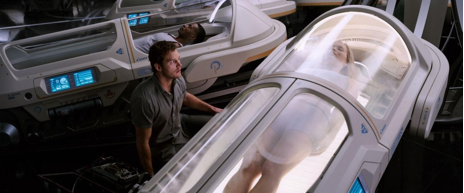Sleeping Beauty on a Spaceship
Skip other details (including permanent urls, DOI, citation information)
: This work is licensed under a Creative Commons Attribution-NonCommercial-NoDerivatives 3.0 License. Please contact [email protected] to use this work in a way not covered by the license.
For more information, read Michigan Publishing's access and usage policy.
Morten Tyldum’s film, Passengers (2016) is about human nature and our resistance to contentment. It tells the story of Jim Preston (Chris Pratt), a traveler on the Starship Avalon. He is on a voyage to a distant colony when his hibernation pod malfunctions; he awakens ninety years too early.
A main theme of the movie is our tendency to seek out “a better way of life,” as the hologram guide explains to Jim briefly after he prematurely awakens during his journey. Later in the movie, Jim explains that he joined the mission because people on Earth replace broken things instead of fixing them; as an engineer, he is excited to go to a place that requires building new things. He suffers one year in solitude on the spacecraft, slowly losing himself day-by-day, much like Sam Bell (Sam Rockwell) in another release by Sony, Moon (Duncan Jones, 2009). At rock bottom, when he’s thinking of opening the airlock to commit suicide, Jim discovers an attractive fellow passenger. After coming to terms with the morality of it, Jim decides to wake her up. The movie offers a twist on Sleeping Beauty, as Jim rouses the aptly named Aurora Lane (Jennifer Lawrence) from her sleep almost a century too early.
Over the next several months, the pair fall in love. The night Jim decides to propose to Aurora with a ring he made himself with materials he scavenges from the ship, the android bartender, Arthur (Michael Sheen) channels his inner Hal and informs Aurora that Jim knowingly woke her up too early. This corrects her previous assumption that it was also a malfunction that was responsible for her misfortune. She curses Jim and runs off. Later, she attacks him in his sleep much like he disturbed her peaceful slumber in her hibernation pod. This action strands her on a ship with only one other conscious human. It seals her fate of living out the rest of her life aboard a spaceship, instead of looking forward to landing on a new world.
The story taps into ideas presented by Peter Biskind in his book, Seeing is Believing. Biskind explores political ideology and the social norms of 1950s American films. Pluralist movies tend to depict experts (such as scientists and lawyers) as saviors. The main character of Tyldum’s Passengers, Jim Preston could loosely be considered a man of science, as he is an engineer who builds and creates things. He tries for a year to solve the hibernation pod problem, but fails.
In The Martian (Ridley Scott, 2015), Mark Watney (Matt Damon), a botanist, consistently solves every problem that arises to eventually save himself by rejoining his crew as they have failed in all their attempts to save him from being stranded in the remote and hostile planet. Conversely, in Passengers, Jim is unable to save himself; he does not come up with the solution. Here, the expert is not all powerful, and doesn’t step in as the person of authority. Instead, Jim assumes what is perceived as a villainous role and awakens Aurora, ensuring that she, like he, will never see the new world as they both had hoped.
At the movie’s climax, we learn that the asteroid seen at the beginning of the film had punched through the walls of the spacecraft, overheating the core. In order to save the ship, the heat needs to be vented out. Jim sacrifices himself for the ship, Aurora, and the other 5,000 people asleep in their pods. He opens the door that stabilizes the core and seemingly dies selflessly.
In yet another take on Sleeping Beauty, but this time a gender reversal, Aurora saves Jim by putting him in the medical pod, which resuscitates him. Jim’s guilt over stealing Aurora’s dream from her, haunts him; he discovers that the infirmary tube can be turned into a hibernation pod. He tells her to get in, allowing her to go back to sleep and successfully make it to the new colony and complete her intended work. Unable to leave Jim to live out decades on his own, she stays with him and they live out the rest of their lives together.
The last scene of the movie shows the crew awakening a few months before the ship is due to arrive at their destination. They are greeted by a forest within the ship, evidence of lives well lived, showing that Jim and Aurora truly found fertile happiness (indeed, they created their own on the ship, instead of on the new planet). They finally came to appreciate where they were instead of constantly being worried about where they were going. Aurora talks about being stranded; she laments that she will be “traveling forever, never arriving.” But, that is human nature. We never feel ready to take on the things we want to participate in; instead, we rely on excuses as to why we can’t do the things we want to do.
When Aurora makes the decision to stay with Jim instead of going back into hibernation, she finally allows herself to symbolically, if not literally, arrive. She lives her life with Jim to the fullest. Earlier in the film she calls Jim a murderer for waking her up; in reality, he saved her. In a continuation of the Sleeping Beauty theme, he was her Knight-in-Shining-Armor, awakening her from her deadly slumber. Had they not both been awake, the core would have overheated and everyone on the ship would have died. He saved her, not killed her. In the process, she had amazing experiences that would have been missed had she never awoken early: She got to space walk and witness a giant red star up close from the observation deck. Her previous curse of “you took my life,” a feeling of despair over a life stolen from her, evolves into a shared expression of joy and communal humanity. Life is what you make of it... here, now, in this moment.
Author Biography
Khara Lukancic is a master’s student in the College of Mass Communication and Media Arts at Southern Illinois University. She’s interested in film studies, particularly the intersection of film criticism and media ethics.




